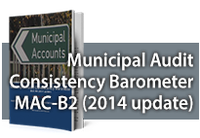Gradual but consistent improvement in audit outcomes from 2008 to 2013
The Multi-Level Governance Initiative (MLGI) launched its Municipal Audit Consistency Barometer (MAC-B) shortly before the national and provincial elections in May 2014 and the publication in July of the Auditor-General’s report for 2012/13.
This report (referred to as MAC-B2 2014 update) is the first update of the barometer, and examines the data from the latest AG report against the background of the new Government’s approach to improving municipal audit outcomes.
The key finding of MAC-B2
• There has been a gradual but consistent improvement in audit outcomes from 2008/09-2012/13.
• Government’s Medium Term Strategic Framework (MTSF) sets new audit targets, one of which is that 75 percent of municipalities should achieve an unqualified audit by 2019. The MTSF targets are much more realistic than the 100 percent clean audit target that was set in the original Operation Clean Audit 2014, reflecting significant policy refinement. On current trends, a shortfall is likely in 2019, and additional interventions and periodic adjustment to actual trends will still be required if the new targets are to be met.
• COGTA has shifted its strategy slightly on how to achieve improved audit outcomes. The new audit targets in the MTSF as viewed as one indicator of local government’s ability to meet long-term targets for capable local government set out in the National Development Plan, rather than as a particular programme. This welcome shift in policy orientation reflects the value of using audit outcomes as a measure of the capability and resilience of local government.
• The bulk of poor audits are coming from smaller local municipalities with largely urban populations dispersed across many small towns (classified as B3s).
• Government has suggested that it may lessen the regulatory burden on smaller municipalities, but any changes to the regulatory regime should not detract from the need for smaller municipalities to build the required competencies and thereby become more resilient.


